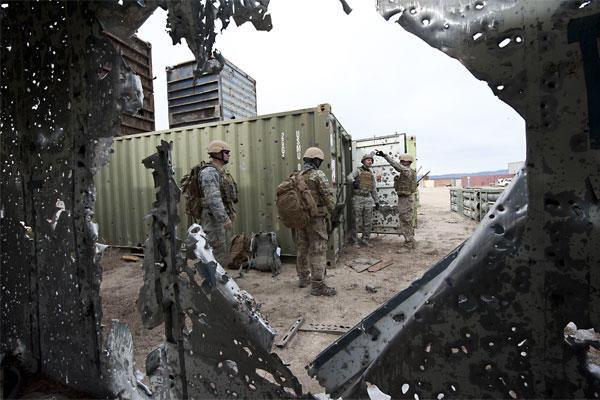PETERSON AIR FORCE BASE, Colo. -- On a bitter cold winter morning explosive ordnance disposal technicians conducted training exercises Jan. 10 at Fort Carson, Colo. designed to simulate the mental and physical fatigues experienced while deployed.
The exercises included unexploded ordnance and improvised explosive devices, called 'problems' by the techs. With each breath visibly clinging to the air, the EOD techs assigned to the 21st Space Wing and 302nd Airlift Wing civil engineer squadrons shuffled 11 miles along a dusty road to their training grounds with each problem tackled by a team of three. It takes well over an hour to render each problem safe, which is why team cohesion as EOD technicians is so important.
"The training gives you the ability to say, 'OK, I know his strengths, I know his weaknesses and he knows mine,'" said Master Sgt. Paul Horton, the 21st CES EOD flight chief. "You want to have your team to operate as smoothly and efficiently as possible, especially in combat, you're in a situation where you don't have time to work kinks out."
In addition to defusing problems while deployed, the 21st EOD technicians also fulfill their role here as a defensive asset.
"We're a defensive asset," Horton said. "We're giving you a safe environment so that you don't have an explosive threat here on the base, whether it's a missile or a grenade or anything that interrupts your ability to execute your mission."
Newly promoted Staff Sgt. Jeremy Redfern, a 21st CES EOD technician, returned from his second deployment in November and understands the importance of these exercises.
"The training allows you to react quickly in really horrible situations," Redfern said. "You just turn everything off, and go back to training."
Redfern has deployed twice to Afghanistan during his five-year Air Force career, first to Helmand province with Horton, and most recently to the Ghazni province.
"Every EOD situation is different, but training takes the edge off to help counter a new situation," Redfern said. "It can be something as simple as remembering Sgt. Horton saying, 'Look at it from a different angle.'"
Providing training is especially important in a life-or-death career field like explosive ordnance disposal.
"We really try to hit our brand new staff sergeants coming up in training to be team chiefs," Horton said. "Historically speaking in EOD, you usually did not become a team leader until around the 6 to 10 year mark. Now we have to push them a little bit harder to get that training out because they don't have the time to develop over several years."
The EOD technicians deploy for six months at a time to areas notorious for IEDs, so training in a controlled environment is vital to provide the skills needed downrange.
While the training was designed to prepare the EOD techs for stressors while deployed, they must also understand the capabilities of their tools and how to respond when those items fail.
"We always call it the ability to adapt to any situation," Horton added. "Your tools can only carry you so far and especially when they break, they break at those key moments, how do you work around that, and that's when you have to work as a team."





























